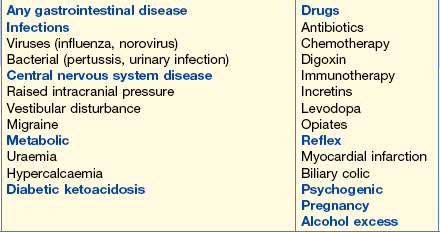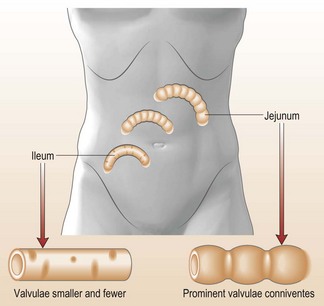4 Gastroenterology
Vomiting
Causes of vomiting are shown in Table 4.1.
• Chest X-ray (CXR). Normal. Look for evidence of air under the diaphragm (perforation), signs of pneumonia, hilar mass (tumour).
• Abdominal X-ray (AXR). Normal. With a history of this length, a normal X-ray would suggest that large or small bowel obstruction is unlikely. High obstruction in the gastrointestinal (GI) tract, i.e. in the oesophagus or stomach, is possible. Investigate for non-GI causes (metabolic, neurological – exclude brainstem lesion), occasionally severe depression.
In this patient, the AXR showed small bowel obstruction (Fig. 4.1). The differential diagnosis is shown in the Information box.
Management
The ultimate goal is to relieve obstruction. In the interim:
• Infuse glucose/saline to maintain electrolyte balance (with additional K+ 20 mmol per litre).
• Insert nasogastric tube (on continuous drainage).
• Contact surgeons, await instruction as to further investigations (such as CT scan to localise obstructive lesion).
Weight loss
What should you do?
• Hyperthyroidism: check for symptoms and signs of hyperthyroidism (see p. 434).
• Alcoholic liver disease (see p. 70).
• Malnutrition: check by asking the patient’s family. Perhaps there is a psychiatric history?
• Underlying cancer, particularly lung, bowel and pancreas.
• Biochemical investigations: should help determine underlying metabolic or renal disease.
• Malabsorption: often causes anorexia, which contributes to weight loss.
This patient had no major signs of chronic liver disease but did admit to recurrent episodes of upper abdominal pain radiating through to his back. These tended to occur on Monday, following his weekend binges. This suggests pancreatic disease resulting from his heavy alcohol intake.
What initial investigations are appropriate?
• FBC, LFTs, calcium, blood alcohol
• Plain X-ray of the abdomen for pancreatic calcification
• Abdominal ultrasound to assess the pancreas for cysts and potential masses.
This patient was admitted in a malnourished, hyperdynamic state due to acute alcohol withdrawal (see p. 72). Treat this initially and further investigate the pancreas later.
Dysphagia
What should you do?
Unfortunately, this woman developed severe chest pain immediately after the dilatation and surgical emphysema could be felt in her neck. Clinically, an oesophageal tear is suspected.
A CXR with a water soluble contrast agent orally, confirms an oesophageal rupture.
Initial management
Small tears in a peptic stricture can resolve in a few days on conservative management. Large tears generally need surgery in a dedicated thoracic unit. Endoscopic stenting is used initially for tears in malignant lesions but again surgery may be required.
Biopsies later confirmed a squamous carcinoma.
Management will include assessment for surgery with:
• Blood count, liver biochemistry
• Abdominal US, CT scan to assess operability
• Endoscopic ultrasound is an accurate way of staging lesion and any local lymph nodes
Discussion should take place at an MDT to decide on the patient’s treatment.
Constipation
This is the infrequent passage of stools, < 3 per week + straining and the passage of hard stools.
Treatment
• Initially, the patient will require a laxative to ‘get things moving’. Glycerol suppositories are useful. Oral magnesium sulphate, an osmotic purgative, is effective and cheaper than the more usually prescribed osmotic laxative lactulose.
• Do not use stimulant laxatives.
• Stop ‘constipating’ drugs if possible.
• Faecal impaction might require digital extraction followed by small-volume phosphate enemas.
• Advise the patient regarding high-fibre diets and fluid intake.
Diarrhoea
What should you do in a case of diarrhoea presenting in A&E?
• Determine frequency, consistency, content of stool, presence of blood.
• Determine the state of hydration and electrolyte balance.
• Send stool for culture, parasites (ova or cysts) and C. difficile toxin (if the patient has previously been hospitalised or been on antibiotics).
• Perform a rectal examination; sigmoidoscopy (if bloody diarrhoea) should be done by the gastroenterology team.
• Do blood cultures in severe cases with a temperature.
Management
This will depend on the case scenario (see below) but most diarrhoeal illnesses are self-limiting and short lived; 1–10% might persist for a month. Identification of the pathogen will determine specific therapy (see Chapter 1).
What immediate action would you take?
• Send stools for ova, cysts and culture.
• Rehydration with oral glucose/electrolyte solutions initially. IV fluids are usually not necessary.
• Vomiting might need to be treated with an anti-emetic (metoclopramide 10 mg × 3/day).
What is the differential diagnosis?
• Infective diarrhoea. Send specimens for microbiological testing.
• First presentation of inflammatory bowel disease (most likely in this woman).
Stay updated, free articles. Join our Telegram channel

Full access? Get Clinical Tree




